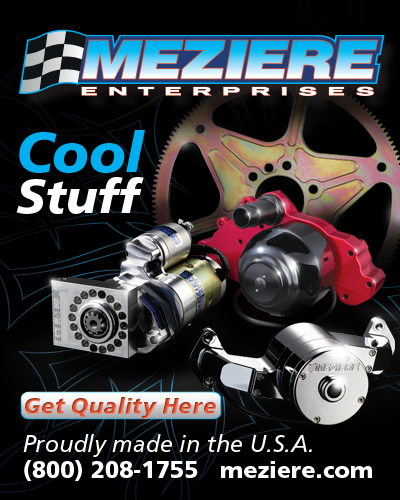THE MUSCLECAR IS ALIVE AND WELL AT THE NMCA
Tue, 2010-04-06 14:10
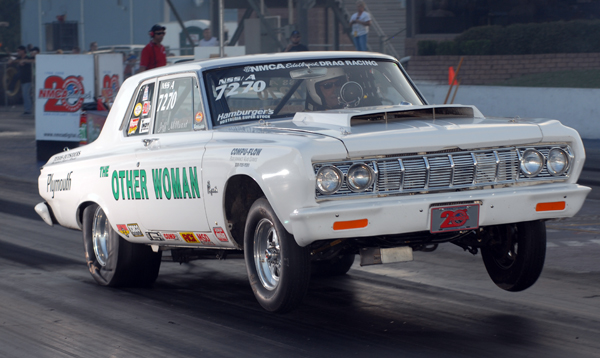 Numerous makes of automobiles have come and gone over the years.
Numerous makes of automobiles have come and gone over the years.The musclecar, however, has held its ground over time. The car was a by-product of 1960s America. The country at that time was being fueled by rebellious youth and automakers capitalized on this prevalent attitude by introducing the muscle car.
In 1962, Dodge and Plymouth immediately found muscle car success by making revolutionary high-performance cars that were sleeker and lighter than other cars on the market, but also had big-car power. The ’62 Dodge Dart 413 was a poster child for Dodge’s early muscle car innovation.
Not surprisingly, these early 60s Dodge and Plymouths ruled the NHRA landscape in the new Super/Stock class.
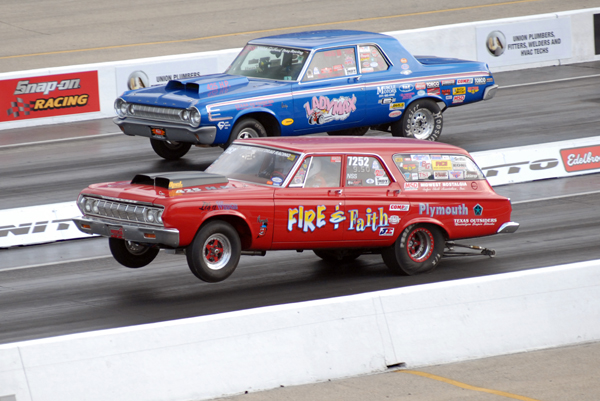
Numerous makes of automobiles have come and gone over the years.

Charlie Harmon, the president of the NMCA, believes his organization is a great fit for drivers chasing their past.
The musclecar, however, has held its ground over time. The car was a by-product of 1960s America. The country at that time was being fueled by rebellious youth and automakers capitalized on this prevalent attitude by introducing the muscle car.
In 1962, Dodge and Plymouth immediately found muscle car success by making revolutionary high-performance cars that were sleeker and lighter than other cars on the market, but also had big-car power. The ’62 Dodge Dart 413 was a poster child for Dodge’s early muscle car innovation.
Not surprisingly, these early 60s Dodge and Plymouths ruled the NHRA landscape in the new Super/Stock class.
By 1964, the Pontiac Tempest GTO set the trend for all muscle cars to follow. That led to cars like the ‘64 Osmobile Cutlass 4-4-2 and the 1965 Chevrolet Chevelle SS 396 to burst on to the racing scene.
The musclecar craze continued into the early 1970s with automakers constantly trying to better each other. Ultimately, however, a changing car market and much stricter government regulations essentially put a halt to muscle car mass production.
The musclecar did enjoy a revival in the early 1980s and it is still present today in modified forms, but frankly nothing compares to the vintage early 60s muscle machines dad used to drive.
Fortunately, drag racers wanting to relive the glory days of muscle cars have a home in the National Muscle Car Association.
The NMCA is an organization which devotes itself to street-car performance. The sanctioning body’s upper classes have evolved into cars similar to modern-day Pro Modified machines, but don’t be fooled because most of these Nostalgia cars are still street legal.
“This is racing the way it should be,” said 54-year-old Dave Schultz, who has been competing in the Nostalgia Super Stock class since 2003.
The NMCA has an eight-race schedule, which began last month at Bradenton (Fla.) Motorsports Park.
Charlie Harmon, the president of the NMCA, believes his organization is a great fit for drivers chasing their past.
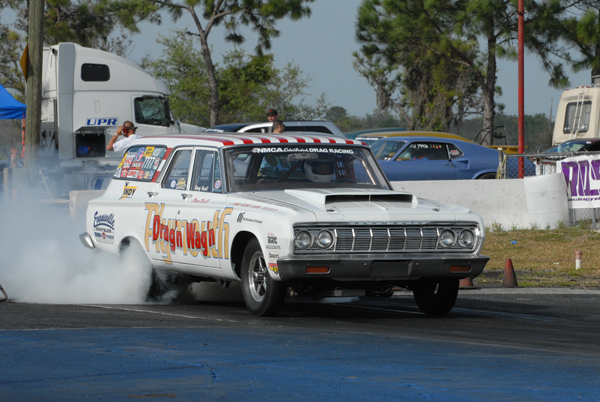
Doug Duell knows all about Nostalgia Super Stock as he won the NMCA championship last season.
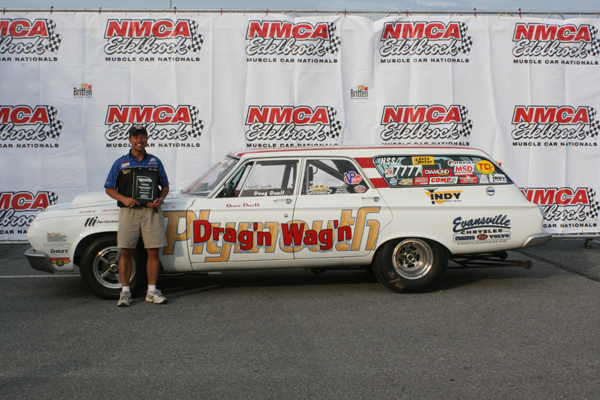

Doug Duell knows all about Nostalgia Super Stock as he won the NMCA class last season. Duell, who competes in a 1964 Plymouth station wagon, dubbed the “Dragon Wagon,” also understands why competitors flock to this type of racing.
“I think for a lot of racers, the muscle cars that were built in the 1960s were their favorite race cars,” said Duell, who is based in Evansville, Ind. “These guys just really enjoy racing their favorite race cars against the same type of muscle cars and maybe a rival car. The biggest venue for us is the National Muscle Car Association and there are other organizations that have three, four, five-race series out there. There are some on the East Coast and the Midwest area, and there a lot of individual events you can go to.”
Schultz looks forward to each NSS season. Dallas Schultz, Dave’s son, also runs in the NMCA, and he was the sanctioning body’s rookie of the year last season.
By midseason, Dave is going to be competing in a new car, a 1964 Plymouth 2-door station wagon. Dallas is driving a black 1965 Dodge Coronet and he’s moving up to the NSS this year. The team is headquartered in Richmond, Texas.
“There about 130 people racing in Nostalgia Super Stock and there are about five of us running 4-speeds,” Dave Schultz said. “I’ve always raced four speeds and this is the type of racing I grew up with. I’m actually one of the younger NSS drivers out here. Most of the guys in the NSS are over 60 and many of them were Super Stock drivers back in the 1960s, and some of them are driving the cars they drove back in the 60s. When I was kid, I used to spend 25 cents every Saturday to buy a Super Stock magazine and I’ve always loved this type of racing. I’m a Mopar man and Mopar’s heyday in drag racing was Super Stock.”
Surprisingly Shultz’s involvement in the NSS came about basically by accident.
“In 2003, I used own a car called the Texas Big Bird,” Schultz said. “It was a Petty-blue Pro Mod and I brought it to race in a big event called the Monster Mopar weekend. Turns out that’s like the biggest Nostalgia Super Stock race event there is. There are like 80 cars that go to that. I never knew that (type) of racing existed. I’m there with my Big Bird car and all of sudden I see all these cars from the late 1950s and 1960s come up there in the staging lanes. These cars used to run 11 to 13 seconds back when I kid and I’m watching them go high 8s and nine seconds on these skinny little tires and I said damn this is something I want to do. I had my 1965 Dodge Coronet I was bracket racing and I converted it into to a Nostalgia Super Stock car.”
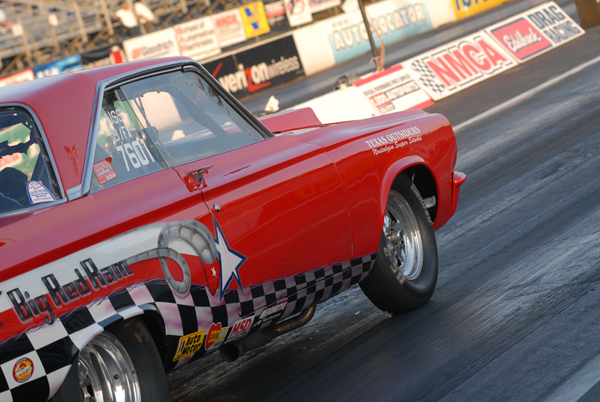
“This is racing the way it should be.” - Dave Schultz, who has been competing in the Nostalgia Super Stock class since 2003.
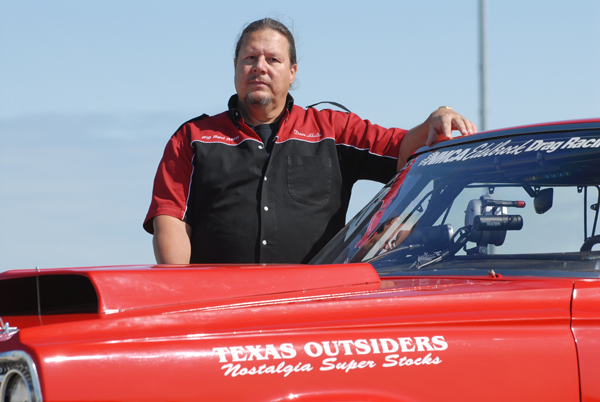

“Without a doubt the rarity of these vehicles make them difficult and expensive to acquire,” Harmon said. “We also are faced with the challenge of informing and creating interest in these older vehicles within the ever growing youth enthusiasts’ who follow the NMCA. However, this is a task we really enjoy.”
Shultz also thinks the NSS class isn’t just for any novice driver.
“The cars that are going faster than 10 seconds are very hard to drive,” Schultz said. “They’re about as aerodynamic as a Coke machine. Then if you’re running a 4-speed with those 10-inch slicks, it’s like launching a car four times. Also, a big challenge I see for Nostalgia Super Stock is getting enough of the young blood to replace the older guys as they go.”
Duell, on the other hand, says the obstacles the NMCA and other Nostalgia series like it face are minimal.
“I don’t think it is a challenge (to keep this type of racing going) because it seems to be growing every year with competitors and events,” Duell said. “It’s a good alternative for a lot of guys because you can build a car for index racing, and because it’s not heads up, you can build a car to go slower. It’s still not cheap because it’s an older car and it’s a race car. Someone can go in at an entry level and build an 11.5 to 12-second car, or if they want, they can go full bore. We have indexes down in the 8s at this point and we have a lot of cars running in the mid 9s. Plus, the thing that people like about this is that it is foot brake racing, so there’s no electronics, and no throttle stops.”
Duell has seen the evolution of the NMCA and Nostalgia racing first hand.
“I’ve been doing this since the mid 90s, and back then about once a month there was somewhere to go,” Duell said. “Literally now, you can’t go to all the events.”
Harmon says the racing niche the NMCA has been able to fill is rewarding in his own right.
“I believe this is an opportunity to fiercely compete in a safe environment with individuals who share common interest and are publicly recognized for their achievements,” Harmon said. “The community that has evolved has become a strong source of satisfaction for our Nostalgia families and friends. Sometimes the post race bench racing and gatherings are as enjoyable as racing to some members of the community.”
Duell concurred with Harmon.
“It’s high-level of competition, so if you do well, it’s very satisfying,” Duell said. “Quite honestly, the best reason to do this is the other racers. It’s just a great group of guys and some girls who run in it (this series) and you see a lot of the same people and they are very good racers who are friendly and it’s a lot of fun to run with them. I don’t know where there this series is going to end up, but it definitely has a bright future. I talk to people everyday who are building cars (to compete in this type of racing).”
Competing in the NSS obviously has become far more than just a hobby for Dave Schultz.
“My biggest goal in life right now is to get the NMCA (championship) ring for 2010,” said Schultz, who was fourth in the Nostalgia Super Stock class a year ago.
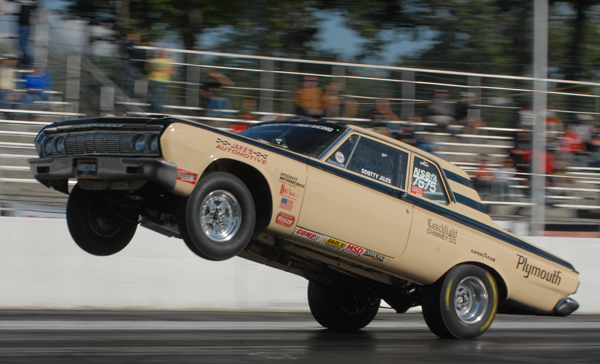
Categories:


























